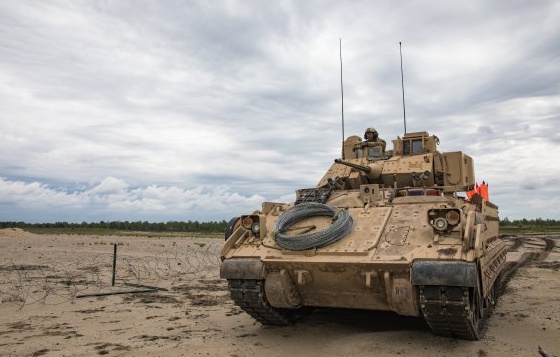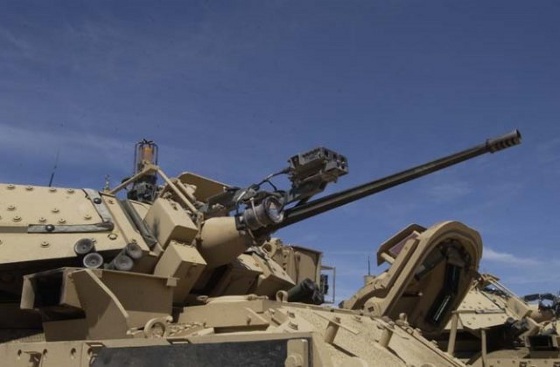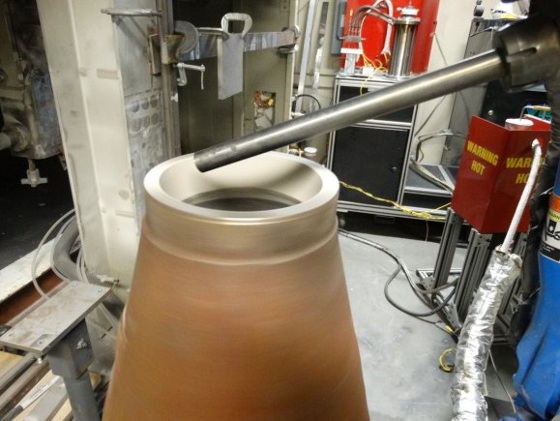 |
| September 10, 2019 | Volume 15 Issue 34 |
Designfax weekly eMagazine
Archives
Partners
Manufacturing Center
Product Spotlight
Modern Applications News
Metalworking Ideas For
Today's Job Shops
Tooling and Production
Strategies for large
metalworking plants
Army develops cold spray technology to repair Bradley gun mounts

An Army M2 Bradley Fighting Vehicle stages out on a breaching range during a dry run of dismounted breach training conducted on a range in Poland, May 23, 2019. With funding from the Army's Manufacturing Technology Program, a team of scientists and engineers from the U.S. Army CCDC worked together to develop a cold spray process to repair costly turret gun mounts on the Army's M2 Bradley Fighting Vehicle. [Photo Credit: Jeremiah Woods]
By Argie Sarantinos-Perrin, CCDC, Aberdeen Proving Ground, MD
Repairing a 40-ton armored vehicle is a lot harder than having your car fixed at a neighborhood auto repair shop. Tactical armored vehicles require specialized repair procedures, which are very costly. What if repairing routine wear and tear on an Army vehicle was inexpensive and as easy as fixing your car?
With funding from the Army's Manufacturing Technology Program, a team of scientists and engineers from the U.S. Army Combat Capabilities Development Command (CCDC) Army Research Laboratory, Ground Vehicle Systems Center, and the Armaments Center, as well as Bradley Product Manager and Red River Army Depot (RRAD) worked together to develop a cold spray process to repair costly turret gun mounts on the Army's M2 Bradley Fighting Vehicle.
"This project demonstrated the ability to apply new manufacturing technologies to bring components back into service that would otherwise be scrapped during depot maintenance operations," said Gehn Ferguson, CCDC ARL materials engineer.
The project began in 2017 when CCDC ARL visited RRAD to view the inspection process and access the wear on the Bradley turret gun mounts. RRAD, the primary depot responsible for the Bradley vehicle, inspects gun mounts for excessive wear. In subsequent months, CCDC ARL developed and demonstrated a process for repairing the gun mounts using cold spray. Prior to developing the cold spray process, worn gun mounts that were inspected and identified as non-repairable were disposed of.

The 25-mm gun mount supports the gun barrel on the M2 Bradley Fighting Vehicle. When the mount begins to wear unevenly, the barrel becomes less stable. The Army is evaluating if a cold spray process can be used to repair the gun mount. [Photo Credit: U.S. Army]
"Cold spray is an emerging technology that will enable the Army to reclaim worn components that were previously replaced with new parts. This new technology reduces lifecycle cost and improves systems availability," Ferguson said.
While the cost of a new 25-mm gun mount is more than $25,000, a cold spray repair costs approximately $1,000. Additionally, the cold spray process improves readiness by reducing the time that a Bradley is out of service while lessening the burden on the supply chain by reducing the necessity for stockpiling new gun mounts.
Cold spray is a process where micron-sized particles are accelerated in a high-velocity gas stream through a nozzle and subsequently consolidated on a target surface. The accelerated particles impact and bond to the surface, resulting in a buildup of the sprayed material. Both the sprayed particles and the target surface remain solid during the process.

Using the cold spray process, CCDC Army Research Laboratory restored the internal diameter of the gun mount exit throat to its original drawing dimensions, demonstrating the ability to return worn gun mounts back into service. [Photo Credit: U.S. Army]
The Bradley turret gun mount was selected as a candidate for the cold spray repair process because CCDC ARL has extensive experience working with similar steels, and an established process to repair the worn gun mounts didn't exist. CCDC Armaments Center was responsible for designing and engineering the turret, and CCDC ARL developed and demonstrated the cold spray repair procedure. The Tank-Automotive and Armaments Command is reviewing the repair and overhaul instructions currently under development. The team plans to repair four or five gun mounts within the next six months.
While the project initially began as a way to repair gun mounts, the material used in the cold spray process is much more durable, which suggests it could even be used to extend the life of new gun mounts.
Cold spray is also being evaluated for use with other applications, including the ability to repair corrosion on combat vehicle surfaces and possibly to coat the interior of cannon barrels. For example, if the inside of a cannon barrel can be effectively coated with tantalum, which is a very durable material, its service life can be extended.
"As the command develops new weapon systems, there will be more opportunities to leverage the cold spray process to augment or repair components that may otherwise be labeled unusable. We're hoping this new manufacturing technology will lead to more success stories that will validate challenging requirements for improved readiness and reduce the lifecycle operation and sustainment costs of current and future tactical systems," Ferguson said.
Published September 2019
Rate this article
View our terms of use and privacy policy
